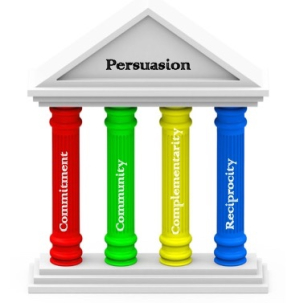By Dr. Ken Broda Bahm:
When we think of persuasion in the courtroom, we might think of the specific language of strategies, tactics, and themes. We think of particular messages that can help get us to our goal. But those are really only the point of the spear. If we think about what is behind the technique, and what gives it heft and effectiveness, then we’re thinking about a number of basic psychological principles of motivation and influence. We are thinking of broad factors that cause people to want to move in a particular direction, factors that relate to some of the more fundamental ways we interact with the world. Of course, those underlying foundations could fill a book, or a library, but it is also possible and helpful to try to boil them down.
One recent attempt to boil them down came in a session called “The Power of Persuasion” at the American Psychological Association’s 125th Annual Convention earlier this summer. The talk, described in this press release, was given by Robert Cialdini, an expert on social influence and professor emeritus at Arizona State University. The gist of his talk was that there are some key levers of influence that have a powerful effect on persuasion, and in most cases, those levers are uncovered rather than created by the persuader in any given situation. In reviewing his comments, I selected four factors that seem particularly fitting for the setting of legal persuasion, choosing a pithy, one-word label to each: commitment, community, complementarity, and reciprocity. In this post, I’ll talk about what each one means and how it applies to trial persuasion.
Commitment
People like to be consistent. The positions people adapt don’t come out of nowhere, they come from prior positions. That is why a juror’s existing general attitudes will bridge to more specific attitudes they develop as they hear a case. It is also why small commitments lead to larger ones. “Once someone is hooked on a product, it’s easier to get him or her to commit to paying for it” Professor Cialdini explains. “When people decide or promise, they tend to stick to their word, according to this principle.” That consistency provides a reason why it is often a good idea to ask for a commitment of some kind in voir dire. Asking jurors, for example, to set aside any ideas they have about plaintiffs, in general, in order to look at this particular plaintiff is a good step. It won’t reveal bias and shouldn’t inform your strikes, but it will serve as an inducement for your juror to want to be consistent with what they have said.
Community
We also gain our opinions from what our community, and more specifically, our ‘tribe’ within that community, thinks. In is an innate pack mentality that informs that thinking, what Professor Cialdini calls “social proof.” It feels more secure and more justified to know that we are not alone in our views, and we are always implicitly or explicitly looking for a like-minded reference group to tell us that we’re right. In the release, Cialdini refers to one of his own studies that “found that guests were 29 percent more likely to reuse their towels if they were told that most other guests chose to reuse the towels. The percentage went up to 39 percent when they heard the majority of guests who had stayed in that room reused their towels.” That kind of social proof isn’t going to explicitly make it into evidence, but jurors will still search for that reference point: What would the typical company do? Did this doctor do what most doctors would have done? Is this product more dangerous than people would expect, or not?
Complementarity
We seek complements to ourselves. Most basically, that means people that we like. It is a basic idea, despite Cialdini calling it the “Principle of liking,” but for witnesses and attorneys, it means that one’s credibility, in practical terms, goes beyond knowledge, comprehension, or even agreement. In order to be fully credible, you also need to be liked. That often boils down to similarity (e.g., ‘we’re both from the same city’ or ‘we’re both self-made individuals’), and can be augmented by sharing some humor or showing that you’re human. The idea of complementarity also accounts for the influence of authority: Where it works, it is because we feel that an expert’s knowledge in an area complements our own need for knowledge.
Reciprocity
The principle of reciprocity comes down to what I’d call the “exchange theory” of communication, or the fundamental and implicit principle of justice that says that what we get should be balanced out by what we give. What that means is that the free sample isn’t really free. ‘This is a simple quid-pro-quo relationship,” Cialdini explains, “where people feel the need to return a favor.” Of course, in trial, you’re not really giving your target audience anything tangible (that would be jury tampering). But, nonetheless, you’re still giving them something. For example, in voir dire, an attorney’s own candor (‘Here’s what I’d be biased against’) can be reciprocated by greater candor from jurors. In opening statement, an open admission of some of the weaknesses in your case might be reciprocated by a greater willingness to see you as honest when you’re talking about your strengths.
Of course, there are more than four such principles. At the layer beneath the persuasive tactics, there are other human motivators. Practical legal persuaders should keep these principles in mind. Knowing why something might work is often more helpful than just knowing that something will work.
______
Other Posts on the Process of Persuasion:
- See Persuasion as a Process (Toward a Unified Theory of Legal Persuasion)
- Know Your Philosophy of Persuasion(Top ‘Perspective’ Posts)
- Let Them Own It
______
Image credit: 123rf.com, used under license, edited.
